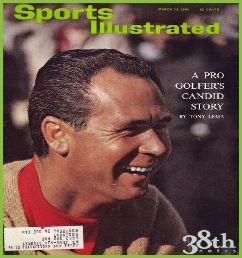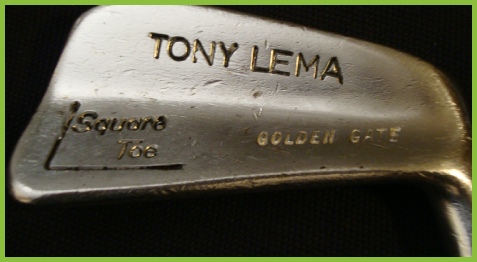
Lema was born in Oakland, California, to parents of Portuguese ancestry. His father died when Tony was three years old, and his widowed mother struggled to raise the family of four children on welfare. He began playing golf as a boy at Lake Chabot municipal golf course and learned different aspects of the game from a variety of people. Noted African-American golf coach Lucius Bateman helped develop his swing, Oakland policeman Ralph Hall taught him course strategy, and the golf pros at Lake Chabot, Dick Fry and Bill Burch, trained him to use a square stance.
At age 17, Lema enlisted in the United States Marine Corps and served in Korea. After his discharge from the military in 1955, he obtained work as an assistant to the club professional at a San Francisco golf club.
Eddie Lowery, a wealthy San Francisco businessman, who assisted talented amateur players in the area, helped to sponsor and encourage Lema. Lowery is best known as the 10-year-old caddy of champion Francis Ouimet during the 1913 U.S. Open. Lowery's sponsorship gave Lema $200 a week expense money, to be repaid, in addition to splitting his winnings: Lema received two-thirds, Lowery one-third. One additional detail was that all debts at the end of the year were to be carried forward.
By 1957, Lema had developed his skills sufficiently enough to earn his way onto the PGA Tour, winning the Imperial Valley Open in memorable fashion: Assuming he was out of contention, Lema headed to the clubhouse bar, where he had three highballs. Told that he would face Paul Harney in a sudden-death playoff, a relaxed Lema won the tournament on the second extra hole. The following year, he began developing friendships with a trio of fellow golfers: Johnny Pott, Tommy Jacobs and Jim Ferree, and during 11 tournaments in 1958, Lema finished in the top 15, winning $10,282 for the year.
The following year, Lema's winnings dropped to $5,900, followed by an even worse year in 1960, when he collected a mere $3,060. A raucous, off-the-course lifestyle was taking its toll until he began talking with television producer Danny Arnold, who helped him improve his composure and bolster his confidence.
While Lema's struggles continued in 1962, along with his debt to Lowery reaching over $11,000, his luck would finally change for good. On the eve of his victory in October 1962 at the Orange County Open Invitational in Costa Mesa, California, Lema joked he would serve champagne to the press if he won the next day. From then on he was known as Champagne Tony, and his handsome looks and vivacious personality added to the legend, such that Johnny Miller has stated that at the time of his death in 1966, Lema was second only to Arnold Palmer in fan popularity.
That win sparked an impressive performance over the next four years that saw him win 12 official PGA tour events, finish second on 11 occasions, and third four times. From 1963 through July 1966, Lema finished in the top-10 over 50% of the time and never missed a cut in a professional major, finishing in the top-10 in 8 of the 15 majors in which he played. He was a member of the 1963 and 1965 United States Ryder Cup teams, and his Ryder Cup record (9–1–1) is the best of any player who has played in two or more.
Friend and tour colleague Jack Nicklaus wrote that Lema's play also stabilized and improved greatly after he married his wife Betty, a former airline stewardess, in 1963.7 One additional reason for Lema's more relaxed play that year was the end of his agreement with Lowery.
In 1963, Lema finished second by one stroke to Jack Nicklaus at the Masters Tournament, and missed the playoff for the U.S. Open by two shots, bogeying the last two holes, believing he needed birdies. He won the Memphis Open Invitational later that summer.
Lema won two other tournaments that fall and was named 1963 Most Improved Player by Golf Digest. That winter, he wrote, with Gwylim S. Brown, "Golfers' Gold", an autobiographical account of his eight-year apprenticeship in the competitive cauldron of the PGA Tour.
In 1964, Lema won the Bing Crosby National Pro-Am at Pebble Beach Golf Links, and then three tournaments in four weeks: the Thunderbird Classic at Westchester Country Club in Rye, New York, the Buick Open Invitational at Warwick Hills Golf and Country Club in Grand Blanc, Michigan, and the Cleveland Open at Highland Park Golf Course in Cleveland, Ohio (in a playoff with Arnold Palmer).
Then, two weeks later, he captured one of the major championships by taking that year's British Open at St Andrews, Scotland, by five shots over Jack Nicklaus. This was an astonishing surprise, since Lema was not only making his first appearance in the championship, but had only nine holes of practice before starting. However, Lema hired Arnold Palmer's regular British caddy, Tip Anderson, since Palmer was not competing that year; Anderson, a descendant of a past Open champion, Jamie Anderson, had grown up on the course and likely knew more about it than anyone else.
In the match up of the four major champions of 1964 in the World Series of Golf, Lema won $50,000 (then the largest payoff in golf) at Firestone Country Club over Arnold Palmer (Masters), Ken Venturi (U.S. Open), and Bobby Nichols (PGA Championship).
In 1965, Lema won the Buick Open for the second consecutive year, and the Carling World Open, finishing second in prize money to Jack Nicklaus. In fall 1965, Lema and Nicklaus formed the U.S. team to the World Cup of Golf.7 Lema's last victory came in May 1966, in his wife's hometown at the Oklahoma City Open. A few weeks later he came back from an opening round 78, to almost capture a third consecutive Buick Open, just losing out to his close friend, Phil Rodgers.
In 1966, at age 32, he was flying from the PGA Championship at Firestone Country Club in Akron, Ohio, with his wife, Betty, to an exhibition tournament, the Little Buick Open in Lincolnshire, Illinois, south of Chicago, when their chartered twin-engine Beechcraft Bonanza ran out of fuel and crashed in a water hazard short of the seventh green of Lansing Country Club in Lansing, Illinois, very close to their destination. During the fatal plunge, the pilot swerved left to avoid a group of people standing near the clubhouse. In addition to the Lemas, two other people, Dr. George Bard and Doris Mullen, were also killed. Bard and Mullen's husband, George, were owners of the ill-fated plane.
Lema and his wife were buried in the Holy Sepulchre Cemetery in Hayward, California, after funeral services at St. Elizabeth's Church in his hometown of Oakland, California.8
In 1983, a San Leandro public golf course was named in his honor, the Tony Lema Golf Course, in his which is now part of the Monarch Bay Golf complex.

